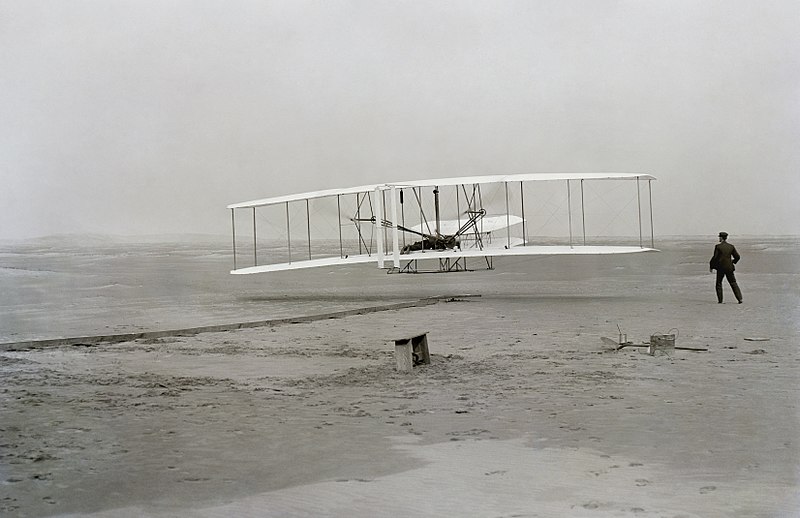This Week In History: The Wright Brothers First Powered Flight
- December 17th, 1903 -
 On a beach at Kitty Hawk, North Carolina, USA, a man called Orville Wright launched the first powered aeroplane into the sky. The flight lasted 12 seconds and took him 120 feet. The picture, left, shows the very moment the flyer took off with Wilbur, his brother, running alongside steadying the wings before take-off. The plane was difficult to control, pitching up and down, before hitting the sand.
On a beach at Kitty Hawk, North Carolina, USA, a man called Orville Wright launched the first powered aeroplane into the sky. The flight lasted 12 seconds and took him 120 feet. The picture, left, shows the very moment the flyer took off with Wilbur, his brother, running alongside steadying the wings before take-off. The plane was difficult to control, pitching up and down, before hitting the sand.
The brothers were two of seven children born to Milton and Susan. Neither of the brothers really excelled academically; Orville was quite a handful and was even expelled from primary school. They put their interest in flight down to a present their father gave them – a toy helicopter made of bamboo and paper and powered by rubber bands. After extensive playing it broke, so the brothers fashioned a new one.
The entrepreneurial pair dropped out of school early and made a printing press. In 1889 they wrote and published a weekly journal called the West Side News. A year later this became a daily journal. Then in 1892, they launched a bicycle repair and sales shop to take advantage of the new craze in bicycles. They even began to design and sell their own brand of bicycle. It was this business that helped them fund their interest in flight. In 1902, the brothers made over 700 successful glider flights. They wanted to attempt powered flight but couldn’t find an engine manufacturer that could supply them with an engine light enough but still powerful enough to power an aeroplane. So, the brothers designed and built their own engine, together with a new propeller that made more efficient use of the power of the new engine which they fitted into their flying machine – a 40 feet long, 605-pound plane with a double tail and elevators.
On December 14th they went to Kitty Hawk, a beach chosen for its windy conditions to help give added lift. They tossed a coin to decide who should go first and Wilbur won. Unfortunately, he oversteered the elevator, climbed too steeply, stalled and crashed, nose first, into the sand.
Three days later after repairs were made, they were back, it was Orville’s turn. They’d notified all the local press but only one reporter turned up. The winds were nearly too strong at 27mph, but they continued. He tested the controls and at 10.35am released the restraining wire. The plane moved down the launching rail with Wilbur running alongside to stabilise the wings. The machine took off and history was made. As said previously the flight did not last long but three more flights were made that day with the brothers taking turns to pilot the machine. It was Wilbur’s second go, the fourth and final of the day, that saw the record flight – 59 seconds and 852 feet. Further attempts were planned but a gust of wind caught the aeroplane, rolled it over and damaged it beyond repair, it would never fly again.
The brothers shipped the plane home and Orville later repaired it and loaned it to several museums including the Science Museum in London in 1928.
The flight didn’t cause much excitement at the time, with many of the newspapers saying that the distances covered were too short to be of interest. It wasn’t until the Wright brother’s ideas were improved and flight became more consistent, that the event on 17th December 1903, was considered a crucial moment in history. That flight, however brief, was to have a profound effect on world history. Travel, warfare, trade and tourism were all to change completely with the advance of flight.
Tips for educators:
- Retrieval practice: ask students to read the Wright Brothers First Flight blog, or read it to them, as appropriate, then once finished, ask students to write as many facts they can remember as possible. The act of retrieving the information afterwards, rather than writing notes as they go along, will actually boost their learning.
- Ask students to give examples of how the development of aviation, since the Wright Brothers first powered flight, has changed history. Consider travel, warfare, trade and tourism etc.
- Download and print our fun Wright Brothers word search activity.
For more teaching resources and This Week in History, connect with us on Facebook, Twitter or Pinterest.
Know an educator who would like this story? Share it with them.


